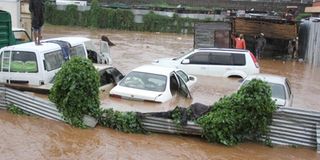Managing climate change billions will require transparent institutions

Submerged vehicles in Eldoret town following heavy rain on August 5, 2014. Due to climate change, the rains are unpredictable and climate-induced problems have become more frequent and intense. FILE PHOTO | JARED NYATAYA |
What you need to know:
- The National Climate Change Action Plan estimates that Sh391-Sh495 billion will be needed to combat climate change in Kenya.
- Kenya has not performed well in attracting funds from global funding.
The climate is changing and the impact is already being felt in Kenya. In recent days, the weather has been changing from freezing cold to very warm, or from very wet to very dry — all in the course of one or two days.
The rains are unpredictable and climate-induced problems have become more frequent and intense. For instance, many counties of northern Kenya are encountering dry spells every year unlike in the past when droughts used to occur every three to four years.
Agriculture bears the brunt of climate change. High temperatures and changes in rainfall patterns increase the chances of crop failure.
They also reduce the amount of pasture and water available for livestock production, leading to massive losses of animals, and reducing even further the total amount of food available.
Climate variability is measured over time, and the most visible impact is the changing environment. Areas which were once considered suitable for certain crops are no longer suitable for the same crops. For example, areas where tea can grow will decline in Nandi, Kericho and Kisii, as they become warmer.
Rising temperatures have resulted in rising levels of sea water. This rise interferes with breeding and feeding environments for fish and other forms of sea life.
In some cases, different types of fresh and salt water fish have been harvested in areas where they are uncommon.
SPREAD OF DISEASES
There is a direct link between climate change and human health. It exposes people to climate-sensitive health risks.
The extreme changes in temperature influence the incidence and geographical spread of many diseases and pests affecting both humans and livestock.
A large proportion of Kenyans lack access to safe drinking water and good sanitation. More El Nino floods will exacerbate the prevalence of vector and water-borne diseases including typhoid, amoeba and cholera.
All these threats could undermine the progress made in tackling disease, malnutrition and infant mortality.
Responding to these challenges will require opening new frontiers in research and development.
Globally, tackling climate change will require industrialised countries to undertake substantial reduction of greenhouse gases, while at the same time financing mitigation and adaptation actions in the most vulnerable regions of the world.
The National Climate Change Action Plan estimates that Sh391-Sh495 billion will be needed to combat climate change in Kenya. These costs are beyond what the National Treasury can afford. Seeking international climate finance is, therefore, imperative.
GLOBAL FUNDING
Kenya has not performed well in attracting funds from global funding.
For instance, within the Kyoto-established Clean Development Mechanism, Kenya has only managed to attract 19 projects compared to China (3,752), India (1,499), Brazil (324), and South Africa (54).
Under the Green Climate Fund, in 2012, funds pledged to Kenya amounted to Sh4.9 billion, while, India was able to attract over Sh13.4 trillion.
The government attempted to mainstream climate change-related activities through the National Climate Change Activities Coordination Committee with little success. Each line ministry set up a unit to coordinate climate change issues.
However, most of these units were poorly staffed and tended to be highly personalised. There were at least 15 different agencies supporting climate change programmes. All the initiatives resulted in confusion, duplication of efforts and poor information sharing.
To remedy this, a taskforce was formed and is currently drafting a National Climate Change Policy Framework. A Bill to that end is before the National Assembly.
Climate change activities will continue to attract investment in the coming years. But without an effective and efficient institutional framework, Kenya will be locked out of these resources.
What is required is an effective institution with the capacity to mobilise international and domestic resources and ensure they are apportioned to activities that improve the ability of communities to mitigate the effects of climate change.
To effectively address climate change, all sectors must implement programmes in an integrated, holistic manner to avoid a situation where unanticipated outcomes are transferred across sectors. It is the little efforts by individual sectors that will matter in the end.
Dr Omiti is the executive director of the Kenya Institute for Public Policy Research and Analysis (KIPPRA)
Email: [email protected]





